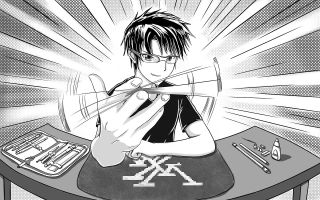Sex
Is There a Link Between Animated Pornography and Pedophilia?
Animated pornography sometimes depicts childlike characters.
Posted May 10, 2023 Reviewed by Gary Drevitch
Key points
- Animated pornography is a form of art that involves fantasy sexuality, sometimes including childlike characters.
- Motives for consuming animated pornography appear to have more to do with escapism and fantasy situations than interest in children.
- It appears unlikely that animated pornography has an effect on sexuality, but instead reflects pre-existing characteristics of the viewers.

Cartoons that depict graphic sexuality are nothing new. So-called “Tijuana Bibles” were small comic books distributed throughout the United States during the Great Depression. The small books often included overtly sexual and pornographic depictions of celebrities, superheroes, and politicians engaging in sex acts, including sexual assaults. “Tentacle Erotica," or shokushu goukan, is a Japanese art form that depicts nude women engaged in sex or being sexually violated by giant octopi. Though the art form dates back to the 1700s, it grew in popularity during periods of censorship post-WWII, when artists drew octopi and tentacles rather than penises. Hentai is another form of Japanese art, involving drawn animated cartoons and graphic novels which often feature childlike characters involved in graphic sexual scenes.
Because most cartoons in modern media are produced for children, sexualized cartoons raise significant concerns. Are these sexualized materials being accessed by children? Are they being produced in order to sexualize child readers and introduce them to inappropriate sexual content? What impact do these drawings have upon readers? Do they lead them to develop a sexual interest in the childlike characters? Finally, do people with pedophilic interests in children access these materials, in an inappropriate manner? These questions are highly current, as numerous policy and legislative efforts are in play to ban such material under arguments that it increases child exploitation. Amazon has recently banned sale of figurines related to manga, under a believed relationship to child exploitation.
A 2003 U.S. Supreme Court decision, Ashcroft v Free Speech Coalition, struck down laws that criminalized drawings and computer-generated images of child sexuality, ruling that they were not illegal child pornography. However, other recent cases in the U.S. have held that they can be ruled obscene.
Who Watches Animated Porn and Why
Research published in 2021 examined the collecting and viewing behaviors of individuals who consume child sexual exploitation material, or child pornography. This research found that offenders had more diverse collections of sexual material than non-offenders, including hentai. In fact, offenders were 5.6 times more likely to have hentai in their collections than non-offenders. This is not to say that only persons with pedophilia consume or collect hentai, but it does appear to be the case that persons with sexual interests in children do seek out this material.
Still, many viewers of such material appear to do so for other reasons. “Yaoi” is a form of erotic Japanese manga which depicts homoerotic love and sex between young males and boys. Surprisingly, this media was created primarily for female readers, by female artists. Research has found that motives for watching this material involved more than just sexual interest. In a study of 724 consumers of yaoi material, 42% of whom were female, a primary motive for most female readers was the idea that such depictions represent a form of “pure love” overcoming gender differences. The pro-gay, forbidden, and transgressive nature of the material also serves as an exciting element for viewers. But the dramatic, emotionally-driven relationship elements of the narratives were a compelling feature for female readers, who wanted to read about relationships and love as opposed to violence or battles, as is common in other Japanese comic books. Male readers of this material were more likely to read it for escapist or sexual arousal motivations, and were more likely to be gay or bisexual, seeking depictions of characters like themselves with whom they could identify. My colleague Justin Lehmiller reports in a post here that gender-diverse and LGBTQ people are more likely to fantasize about hentai.
Animated erotica allows the depiction of things that are impossible in the real world. These impossibilities include sex with giant tentacled octopi and other monsters, and with fantasy creatures such as elves or aliens. Dahlquist and Vigilant review these motives and suggest many consume such material because it is “way better than real.” They note that readers describe that the characters are able to engage in superhuman feats of sexuality in impossible positions and engage in sexual behaviors that transcend the limits of human physiology. “Hentai is pure simulacrum. It does not claim to be a simulation of a 'simulation of the real' things of human pornographic sex acts…Instead, hentai is presented as a better unreal experience." Thus, animated erotica offers a postmodern view of sexuality that overcomes the drudgery of real-life human sexuality, depicting a liberated form of sexuality in which gender, sex, and species ambiguities can be explored in experimental, fantastic ways.

What's the Impact of Watching Animated Porn?
Few studies have examined the impact of reading such material. One publication analyzed Japanese manga and graphic novels, and demonstrated that the material included high levels of aggression, including relational aggression, although there was more physical and verbal aggression than relational. A subsequent study of 223 middle school students from the Midwest United States found that about 20% read manga. Those youth who read the more aggressive forms of manga were more likely to also engage in physical aggression in real life, though the authors indicate this is likely not purely causal, but rather reflects that violent, aggressive youth are more likely to be drawn to violent, aggressive material. However, even those youth who read aggressive manga were no more likely than peers to engage in real-life relational aggression. The researchers argued that personality characteristics of the youthful readers may be more important elements than merely focusing on the material itself.
A 2021 study involved one of the only explorations of differences between individuals who consume animated pornography and those who watch human pornography. In the study, 208 participants were divided into those who watched both animated and human porn, those who watched only animated material, and those who watched only human porn. The sample had more females (133) than males (75). Female viewers who preferred hentai were more likely to have higher levels of anxiety and anxious attachment, as compared to female viewers of human porn. Viewers who preferred hentai were more likely to report romantic feelings of love and relationship desires for anime characters, but were as likely to report such feelings for humans, as were viewers of other forms of porn. Despite the researchers’ expectations, hentai viewers were not more avoidant of attachment in their relationships. As the researchers stated, "consuming hentai may not change people’s attraction and desire towards real humans.”
As with all forms of pornography, children shouldn't view hentai or animated pornography. There's no indication that it's made for them; it's produced for older viewers. However, preparing young people to encounter such material and seek support from adults is likely to be the most effective strategy to prevent children from being confused or miseducated by such content.
At this point, there are no known studies that examine, over time, whether the consumption of animated pornography has any demonstrative effect on sexual desires or expression. Certainly, such studies in children or adolescents would be highly unethical. Sam Louie, in a post on this site, argued that he has seen viewers of animated porn experience a change in their arousal template, shifting to find more deviant images arousing. Unfortunately, there’s no scientific evidence for this, and more likely indications that people seek out material, including animated content, that matches their pre-existing sexual interests and personalities. Sexually deviant interest, particularly sexual desire for children, appears to be a highly biological, inborn trait, not one that morphs, as Louie hypothesizes.
However, it does appear that viewing such material may be an expression of sexual interest in children, in people already predisposed to have such attractions, and thus it may be important to examine whether pedophilia is present in viewers of such material. However, many viewers of such material, and especially female viewers, gravitate toward it for reasons other than sexual interest in childlike characters. Instead, the narrative, the impossible, fantasy realities, and the depiction of transgressive, non-gender-driven relationships appear to be the primary motives for most viewers. For many, the ability to use such material to escape anxieties connected to the real world, or to real-life sexuality, may indicate potentially valuable areas of clinical exploration. In other words, it’s more valuable to explore what this material does for a viewer than to explore hypotheticals about what it may do to them.




